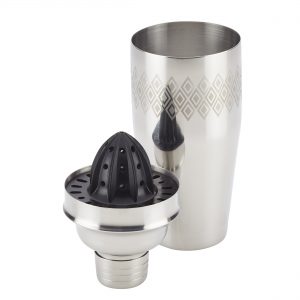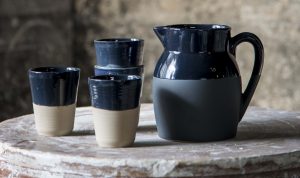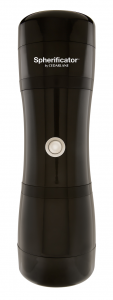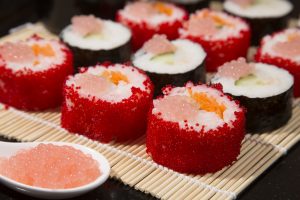Home Entertaining
Duralex Presents Empilable Mugs for Cheese Foam Tea
 Duralex, the French glassware maker known for Picardie tumblers, presents the Empilable mug for Cheese Foam Tea, the hottest drink on the internet. Cheese Foam Tea is made with cold black or green tea that is topped with a foamy layer of milk, cream cheese and a sprinkle of salt. The clear glass mug shows off the colors and swirls of this trending beverage blending a little auberge French style with the Asian-inspired beverage.
Duralex, the French glassware maker known for Picardie tumblers, presents the Empilable mug for Cheese Foam Tea, the hottest drink on the internet. Cheese Foam Tea is made with cold black or green tea that is topped with a foamy layer of milk, cream cheese and a sprinkle of salt. The clear glass mug shows off the colors and swirls of this trending beverage blending a little auberge French style with the Asian-inspired beverage.
Empilable, French for stackable, is a mug that is truly transparent and strong. Duralex invented a tempering process that toughens up their glassware to withstand daily wear and tear. Its throwback style is crystal clear brandishing the nuances of this creative drink sensation. The stackability and strength of the mugs make them versatile for both hot and cold beverages.
The basic Cheese Foam Tea recipe is simple and can be made at home with just a few ingredients. Find a Cheese Foam Tea recipes on the Duralex USA facebook page.
Empilable mugs, like all Duralex glassware, are made in France and can last for decades. If broken, they shatter into small chunks rather than jagged shards—and are microwave, freezer and dishwasher safe. Duralex has been manufacturing tempered glassware, through a process they invented, in the heart of France since 1945.
Ayesha 4-in-1 Metal Cocktail Shaker

The innovative Ayesha 4-in-1 Metal Cocktail Shaker from Meyer Corporation, U.S. conveniently combines measuring, juicing, shaking and straining with one easy-to-use and cleverly styled tool. The top of the lid detaches to serve as a 1-ounce jigger, and a citrus reamer is built into the inside of the lid to juice lemons, limes and other citrus fruit. The lid securely fits into the base to prevent leaks when shaking, and the shaker also strains the cocktail without requiring a separate tool. Suggested retail price is $24.99.
Authentic Stoneware for a Touch of Farmhouse Kitchen Style
By Lorrie Baumann
Stoneware from La Manufacture de Digoin has now become part of the extensive range of fine European imports offered by The French Farm. While The French Farm’s product range is centered on fine foods, it also includes cutlery collections by Jean Dubost, handcrafted olive wood utensils from Berard, lavender-scented personal and home care products from Le Chatelard 1802, Jacquard tea towels from Coucke, The French Farm collection of wood cutting and service boards, and now, traditional farmhouse-style stoneware items from La Manufacture de Digoin. “Since we do very well with housewares, I decided to bring in the Digoin line a few months ago. People have seen it in gift shows in France,” said Gisele Oriot, The French Farm’s Founder. “It has been a really old-fashioned line that has had a new look by the new owner of the company.”
 The new stoneware was made in a French factory in Burgundy that was founded in 1875 as a family-owned business that specialized in handcrafted pottery and made the kinds of objects typically found in a 19th-century French farmhouse kitchen – the pitcher for the milk, the jug for the cool drinking water, the crock for the pickles. “I’m actually from Burgundy, and we still have my grandfather’s farm, and there was always a brown jug and a jar, and everything was manufactured by the Digoin company,” Oriot said. “It would say ‘Digoin’ on the item. Everything was brown – no red, no yellow, just brown.” Once those farmhouses gained electric power, the need for many of those objects was superseded by refrigeration. Cheap plastics came into those kitchens, and the factory’s business declined. The company was in its last throes when it was rescued by Corinne Jourdain and a group of investors. “Her ambition was to perpetuate a historical expertise and to bring back to former glory those meaningful culinary objects,” according to the company.
The new stoneware was made in a French factory in Burgundy that was founded in 1875 as a family-owned business that specialized in handcrafted pottery and made the kinds of objects typically found in a 19th-century French farmhouse kitchen – the pitcher for the milk, the jug for the cool drinking water, the crock for the pickles. “I’m actually from Burgundy, and we still have my grandfather’s farm, and there was always a brown jug and a jar, and everything was manufactured by the Digoin company,” Oriot said. “It would say ‘Digoin’ on the item. Everything was brown – no red, no yellow, just brown.” Once those farmhouses gained electric power, the need for many of those objects was superseded by refrigeration. Cheap plastics came into those kitchens, and the factory’s business declined. The company was in its last throes when it was rescued by Corinne Jourdain and a group of investors. “Her ambition was to perpetuate a historical expertise and to bring back to former glory those meaningful culinary objects,” according to the company.
For Jourdain, that meant keeping the company’s traditional craftsmanship but updating its sense of style, starting with the addition of colored glazes that would fit into the modern design aesthetic of a contemporary kitchen. “’Let’s do some blue. Let’s do some green.’ She basically took a new look at the whole line,” Oriot said. “This was in 2014. It’s starting to catch on. They’re selling to gift shops and upscale restaurants in France. She’s making it fashionable again.”
Oriot saw the new line for the first time in one of those gift shops when she went back to France on a visit to family there. Then she found out that the factory was nearby and offered tours – and also factory sales. “I went to see the old factory, and it was like magic. There was all this clay, and she had all these beautiful colors,” Oriot recalls. “I took a tour and asked her if she had a distributor in the U.S. She didn’t.”
Oriot placed an order, added the line to her catalog and premiered it at a New York gift show. “We’re shipping everywhere now,” she said. “There is interest in the line.” The collection offered in the U.S. by The French Farm includes a Large and Small Jug, Cruet, Canister with Lid, Vinegar Jar, baking dishes, salad and serving bowls, a utensil crock and terrines like those that French charcuteriers once used in their shops. “The butcher or the charcuterier would bake their recipe in those big brown dishes,” Oriot said. “They would finish the pate and clean it [the terrine] and bake another one in it and sell it by the slice.”
The stoneware is durable and oven-safe, she added. “You can cook in it. It’s very, very strong.”
For more information, visit www.thefrenchfarm.com.
Juicy Turkey, Flavorful Gravy from the SRT
By Lorrie Baumann
The SRT (Special Roasting Tray) from Benno’s Kitchen is the roasting pan for the home cook who’s preparing the Thanksgiving turkey for a crowd who loves a juicy bird but thinks that maybe the best part is the dressing drenched in gravy. It was invented by a home cook who knows exactly how that feels.
Benno Kuttruff describes himself as a hobby cook who used to have trouble basting his turkey. He’d take the pan out of the oven and then ask someone else to hold it while he spooned the pan juices over it. “It’s a little dangerous because everything is hot,” he said. He tried using an American-style turkey baster, but that didn’t work well for him either. “For the nozzle, you have to add water in the beginning,” he said. “Then it splashes.”
He consulted the Internet for answers to his problem. “There was nothing on Google,” he said.
He decided that he’d just have to come up with an answer for himself. He sketched out a design for a slotted tray set over a pan with a stopcock on the side. Juices from the turkey or the lamb roast or the beef drip down through the tray’s slots and into the pan below, where they collect and condense instead of simply evaporating away. When it’s time to baste, the home cook opens the stopcock, which is equipped with a filter to keep it from clogging, drains some of the juices into a cup and pours them back over the protein. When cooking is done, the juices are easily collected to make a base for the gravy. The pan’s special design produces much more of the juice than an ordinary open roasting pan. “After two hours with a big turkey in a regular pan, most of the liquid evaporates,” Kuttruff said. “With the SRT, it doesn’t…. This means that for the turkey, you get a lot of gravy.”
Kuttruff took his sketched design to a friend who fabricates steel. Six or seven prototypes later, after a lot of experiments to make sure that the drain hole was the correct size and the addition of a filter to prevent clogging, and they had a version that’s ready for sale.
After coming up with a model that’s correctly sized for American ovens, Kuttruff had planned to introduce his SRT to the market at this year’s Inspired Home Show, only to see that plan foiled by the COVID-19 pandemic. He did the next-best thing: he videoed his demonstration and posted it on YouTube.
Though the SRT was originally designed for a turkey – it’s large enough to roast a 17-pound bird – its uses aren’t limited to that. Chicken or spare ribs or fish also turn out juicy and flavorful when cooked on the SRT, he says. For salmon, he likes to put some vegetables and a little white wine into the reservoir and lay the fish on the tray. The vegetables add their aromas to the steam that rises to cook the fish, and then after 20 minutes, the fish is done, and the home cook just opens the drain to release the liquid into a saucepan and use it as the base for a flavorful sauce.
When he’s cooking pork on the SRT, Kuttruff likes to use beer as his basting liquid. The beer turns into an aromatic steam that cooks the pork. Kuttruff bastes it during the cooking, so that it comes out of the oven juicy but with a crispy skin. “You just have to open the drain and then you get a monster sauce,” he said.
For more information, email benno@bennoskitchen.com.
Spherificator Brings Culinary Wizardry to Home Cooks
By Lorrie Baumann
 This year at The Inspired Home Show, Cedarlane Culinary had intended to build on the buzz its Spherificator created at last year’s show, but those plans, as is the case with so many, were foiled by the COVID-19 pandemic. The Spherificator is a device for transforming drops of liquid into the trendy pearls that high-end chefs have taken to using as garnishes for all manner of dishes. Taking cues from molecular gastronomists, now home cooks can use the Spherificator to garnish sushi with ginger pearls, decorate chocolate mousse with coffee caviar or drop rum pearls onto eggnog. “Richard Blais does horseradish caviar, freezes it in liquid nitrogen and serves it on oysters so it comes out smoking from the nitrogen,” said Dustin Skeoch, co-Founder of Cedarlane Culinary. “I’ve seen other chefs that will make 10 to 15 different flavors of pearls and serve them all as a pearl salad.”
This year at The Inspired Home Show, Cedarlane Culinary had intended to build on the buzz its Spherificator created at last year’s show, but those plans, as is the case with so many, were foiled by the COVID-19 pandemic. The Spherificator is a device for transforming drops of liquid into the trendy pearls that high-end chefs have taken to using as garnishes for all manner of dishes. Taking cues from molecular gastronomists, now home cooks can use the Spherificator to garnish sushi with ginger pearls, decorate chocolate mousse with coffee caviar or drop rum pearls onto eggnog. “Richard Blais does horseradish caviar, freezes it in liquid nitrogen and serves it on oysters so it comes out smoking from the nitrogen,” said Dustin Skeoch, co-Founder of Cedarlane Culinary. “I’ve seen other chefs that will make 10 to 15 different flavors of pearls and serve them all as a pearl salad.”
The Spherificator isn’t actually new – an industrial version of the device was developed in Montreal by an inventor who used it to make Kelp Caviar, a cheaper substitute for real roe. Cedarlane Culinary acquired the company in 2018 and then impressed crowds at last year’s International Home + Housewares Show. “The booth was packed the whole show. We had tons of international distributors that we’d never heard of, and we found some American independent retailers and larger chains who wanted to take it on as well,” Skeoch said. “It was easily the best housewares show we’ve ever done.”
 The Spherificator retails for $99 and comes with the device plus enough of the sodium alginate and calcium chloride that make the gel membrane that encapsulates the liquid to make enough pearls for about 50 dinner parties. After the supplies that come in the box have been exhausted, more is available from Cedarlane in Canada or Modernist Pantry in the U.S. The Spherificator also comes with a recipe booklet of 18 chef-developed recipes.
The Spherificator retails for $99 and comes with the device plus enough of the sodium alginate and calcium chloride that make the gel membrane that encapsulates the liquid to make enough pearls for about 50 dinner parties. After the supplies that come in the box have been exhausted, more is available from Cedarlane in Canada or Modernist Pantry in the U.S. The Spherificator also comes with a recipe booklet of 18 chef-developed recipes.
For the retailer, it’s a device that demonstrates well in the shop. “Seeing it in person really helps,” Skeoch said. “You can use just about any food or liquid and turn it into perfectly consistent caviar pearls to take your plating and presentation up a few notches.”
To make the pearls, the user mixes liquid with sodium alginate, a natural seaweed extract in the form of a powder that’s blended into the liquid. It thickens the liquid just a little bit. “You put that in the top of the machine,” Skeoch said. “Then you push the button on the machine, and it comes out as perfect little droplets.”
Those droplets fall into a bath made with the calcium chloride, a natural salt that’s a close relative of table salt, and water. “Each little droplet, when it hits the water, the calcium reacts with the alginate to form a thin membrane around each drop,” Skeoch said. “You can do this the old-fashioned way with a syringe or squeeze bottle slowly dripping one drop at a time into the bath, but it takes forever, so people who have done it that way in the past absolutely love how quickly our new version pumps them out!”
 When the pearls are bitten, the liquid inside gushes out in a burst of flavor, so they’re a functional ingredient in the dish, but their primary appeal is in elegant presentation – and, of course, as a way for a dinner party host to make a splash. “You get a hit of flavor with every bite, but it’s really all about the visuals,” Skeoch said. “It’s an easy way for a foodie to elevate the plating. You don’t see this kind of advanced plating at most dinner parties.”
When the pearls are bitten, the liquid inside gushes out in a burst of flavor, so they’re a functional ingredient in the dish, but their primary appeal is in elegant presentation – and, of course, as a way for a dinner party host to make a splash. “You get a hit of flavor with every bite, but it’s really all about the visuals,” Skeoch said. “It’s an easy way for a foodie to elevate the plating. You don’t see this kind of advanced plating at most dinner parties.”

You must be logged in to post a comment.